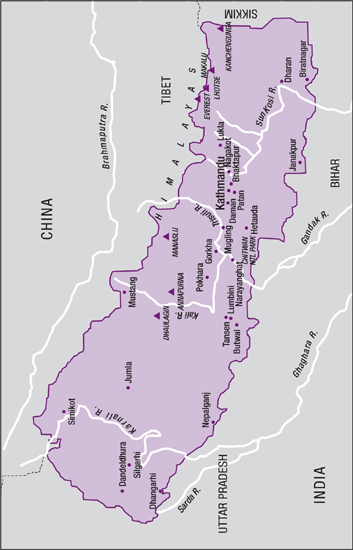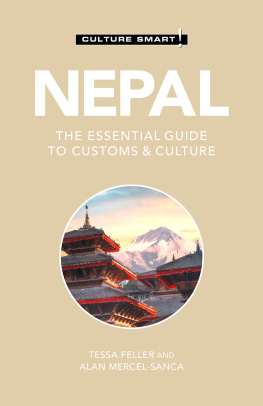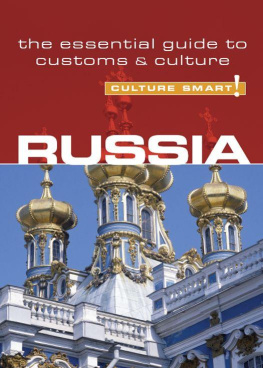First published in Great Britain 2008
by Kuperard, an imprint of Bravo Ltd
59 Hutton Grove, London N12 8DS
Tel: +44 (0) 20 8446 2440 Fax: +44 (0) 20 8446 2441
www.culturesmartguides.com
Inquiries:
Culture Smart! is a registered trademark of Bravo Ltd
Copyright 2008 Kuperard
Second printing 2009
All rights reserved. No part of this publication may be reprinted or reproduced, stored in a retrieval system, or transmitted in any form or by any means without prior permission in writing from the publishers.
Series Editor Geoffrey Chesler
eISBN: 978-1-85733-594-1
British Library Cataloguing in Publication Data
A CIP catalogue entry for this book is available from the British Library
Cover image: Stupa and prayer flags at Bodhnath. Travel Ink/David Guyler
Images courtesy of Stefan Feller
Images reproduced under Creative Commons License Attribution 2.5: iStockphoto
v3.1_r1
About the Author
TESSA FELLER studied German and Spanish at Edinburgh University before training as a teacher and translator. She has worked in several countries, including Austria, Russia, and Germany, where she is now based. She lived in Nepal from 2002 to 2004, when her husband was posted there with the German Development Service (Deutscher Entwicklungsdienst). Her youngest son was born in Kathmandu.
The Culture Smart! series is continuing to expand. For further information and latest titles visit
www.culturesmartguides.com
The publishers would like to thank CultureSmart!Consulting for its help in researching and developing the concept for this series.
CultureSmart!Consulting creates tailor-made seminars and consultancy programs to meet a wide range of corporate, public-sector, and individual needs. Whether delivering courses on multicultural team building in the USA, preparing Chinese engineers for a posting in Europe, training call-center staff in India, or raising the awareness of police forces to the needs of diverse ethnic communities, it provides essential, practical, and powerful skills worldwide to an increasingly international workforce.
For details, visit www.culturesmartconsulting.com
CultureSmart!Consulting and CultureSmart! guides have both contributed to and featured regularly in the weekly travel program Fast Track on BBC World TV.
contents
Map of Nepal

introduction
In the popular imagination, Nepal is a land of eternal snow, where heroic mountaineers and Sherpas valiantly plant flags on the roof of the world, or perish in the attempt. And yet there is far more to Nepal than the ultimate challenge to mountaineers. It has to be one of the most diverse countries in the world, for its climate, scenery, flora, fauna, and not least on account of the complex variety of its cultural, ethnic, and religious weave.
Contrasts and incongruities abound: spectacular snowcapped peaks rise above dusty plains; the Abominable Snowman meets abominable heat; two-, three-, and four-wheeled vehicles careen chaotically around an overcrowded capital, while in the mountains, nothing moves faster than a mule. The beauty of Nepals people, landscape, and vegetation stands out against a background of dust, dirt, and urban ugliness. There are many divisionsbetween rich and poor, urban and rural, highlands and lowlands, privileged and penniless, high caste and untouchable, andrecentlyking and country. And yet a certain unity in diversity binds the country together.
Never a colony, Nepal was isolated from the rest of the world for centuries. Its extreme terrain has both protected it from outside influence and slowed its development. Its relative inaccessibility has allowed pockets of contrasting cultures to flourish. At the same time, these have largely coexisted in peace, thanks to a tolerance, openness, and mutual respect that prevail by and large to this day.
The country has been torn apart over the last decade by civil war, and thrown into despair by the loss of its royal family in 2001. And still the people you meet remain stoic, fatalist, accepting what befalls them. They continue to rise and retire with the sun. Agricultural rhythms dictate the pace of life. The suffering caused by civil strife may be great, but it is not something they wish to bother visitors with.
Culture Smart! Nepal introduces you to the cultural, ethnic, and religious mosaic that is Nepal. It seeks to explain the complexities of all aspects of Nepalese life, from the home, to the marketplace, to the office. It describes how the countrys geography and history have helped shape contemporary society, and how religion defines social structures and leaves its indelible imprint on the Nepalese mentality. It helps you to understand Nepalese attitudes and values, giving you an idea of what to expect, and how to avoid faux pas.
You are unlikely to meet an unfriendly face in Nepal. It may be one of the ten poorest countries in the world, but you will always be made welcome. Whatever the reason for your visit, understanding the cultural backdrop will help you get beyond the friendly smiles and greetings, making it an extremely enlightening and rewarding experience. Namaste!
Key Facts
| Official Name | State of Nepal (since 2006) | Previously: Kingdom of Nepal |
| Capital City | Kathmandu | Pop. of Kathmandu valley (cities of Kathmandu, Patan, and Bhaktapur): c. 1 million |
| Main Cities | Pokhara | Pop. c. 200,000 |
| Area | 56,827 square miles (147,181 sq. km) | Officially, Nepal uses the metric system. In practice, both metric and imperial are used. |
| Geography | Landlocked, between Tibet/China to the north and India to the south | On a latitude with the Sahara Desert/Florida (28 00 N, 84 00 E) |
| Terrain | Rugged Himalayas in north, central hill region, flat river plains in south |
| Land Use | Arable land 16.07%. Permanent crops, 0.85%: other, 83.08% | Most Nepalese are subsistence farmers. Best agricultural land is on southern plains |
| Climate | Alpine climate in high mountains, temperate central valleys, subtropical southern plains |
| Population | 28,901,790 (est. July 2007) |
| Life Expectancy | 60.78 for men; 60.33 for women |
| Age Structure | 014 yrs: 38.3%; 15-64 yrs: 57.9%; 65 yrs and over: 3.8% |
| Literacy | 48.6%: 62.7% men, 34.9% women |
| Ethnic Make-up | Chhetri 15.5%, Bahun 12.5%, Magar 7%, Tharu 6.6%, Tamang 5.5%, Newar 5.4%, Muslim 4.2%, Kami 3.9%, Yadav 3.9%, other 35.5% |
| Languages | Nepali 47.8%, Maithili 12.1%, Bhojpuri 7.4%, Tharu 5.8%, Tamang 5.1%, Newar 3.6%, Magar 3.3%, Awadhi 2.4%, other 12.5% |






